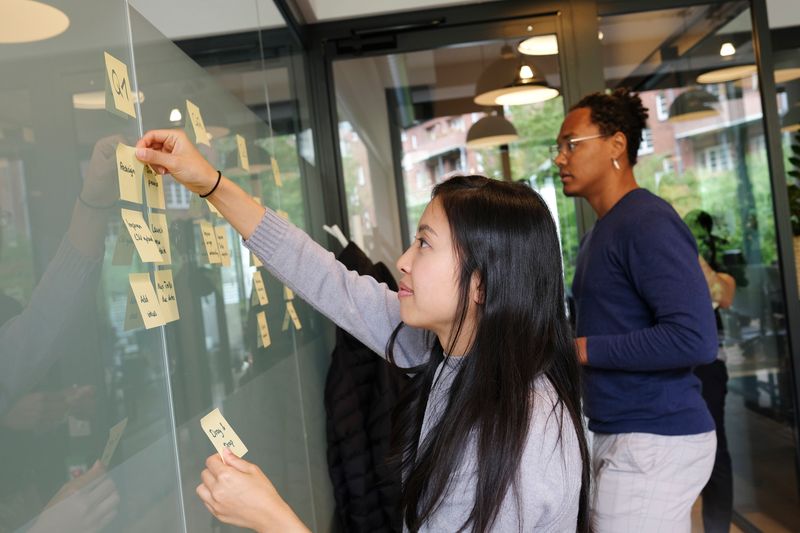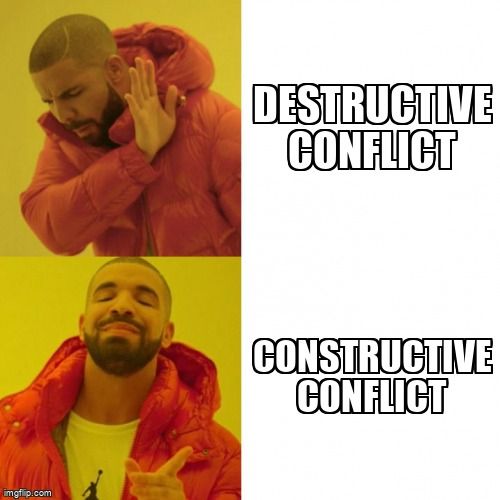Conflict in the workplace can be uncomfortable, but it's not necessarily a bad thing. When handled constructively, conflict can help foster a positive work culture.

What is Constructive Conflict?
Constructive conflict is when employees feel comfortable to challenge prevailing views and ideas when it’s done with the overall betterment of the team and/or company in mind.
 Photo by airfocus on Unsplash
Photo by airfocus on UnsplashConstructive conflict can be a game-changer in the workplace and can lead to:
stronger team cohesion
greater innovation
improved productivity
Stronger Team Cohesion
Relationships are the foundation of a healthy and thriving workplace. When people and teams engage in respectful and collaborative communication to resolve conflicts, it can strengthen relationships and build trust.
 Photo by Mimi Thian on Unsplash
Photo by Mimi Thian on UnsplashConstructive conflict nurtures a healthy and thriving work culture by:
 Encouraging open communication: By providing a safe and welcoming space to share ideas, individuals might feel there are fewer barriers to challenging but necessary conversations.
Encouraging open communication: By providing a safe and welcoming space to share ideas, individuals might feel there are fewer barriers to challenging but necessary conversations.
 Building trust: Creating a comfortable environment for giving and receiving feedback can improve collaboration and foster teamwork toward common goals.
Building trust: Creating a comfortable environment for giving and receiving feedback can improve collaboration and foster teamwork toward common goals.

Providing a framework for conflict resolution: This can lead to improved conflict resolution skills and stronger relationships among team members.
 In a marketing team, Alex and Maya have conflicting ideas on a new advertising campaign. Instead of avoiding the conflict, they engage in a constructive discussion, sharing perspectives and data.
In a marketing team, Alex and Maya have conflicting ideas on a new advertising campaign. Instead of avoiding the conflict, they engage in a constructive discussion, sharing perspectives and data.
They reach a consensus to combine strategies, leading to a stronger campaign. The experience fosters trust and respect, enhancing team cohesion.
Fostering a Culture of Innovation
Constructive conflict can lead to greater innovation in the workplace. When team members feel comfortable challenging each other's ideas and proposing alternatives, it can lead to new and innovative solutions.

Constructive conflict fosters a culture of innovation by:
Encouraging diversity of thought: Team members with different backgrounds, experiences, and perspectives can share their ideas and perspectives. This can lead to a wider range of ideas and approaches, promoting innovation.

Promoting experimentation: By creating a safe space, employees feel empowered to take risks and try new things. When they know that "bad ideas" won't be attributed to them, they're more likely to feel motivated to experiment and try new approaches.

Supporting learning: By creating a culture of continuous improvement, employees are more likely to take an active role in their own learning and development.
 During a brainstorming session, team members John and Sarah have contrasting ideas for a new product feature.
During a brainstorming session, team members John and Sarah have contrasting ideas for a new product feature.
They engage in constructive conflict, challenging and debating their ideas. Through this process, they uncover new possibilities and combine elements from both concepts, leading to an innovative solution.
The team's culture of embracing constructive conflict encourages creativity and pushes boundaries, resulting in a continuous stream of innovative ideas.
Improved Productivity
Constructive conflict can positively impact performance and drive better results in the workplace as it provides employees an opportunity to critically analyze ideas in a safe space.

Employees and teams can achieve their full potential and contribute to organizational success when they:

Encourage critical thinking: When team members engage in constructive conflict, they're forced to think critically about their own ideas and the ideas of others. This can lead to better problem-solving and decision-making.

Reduce groupthink: Constructive conflict can challenge groupthink, which occurs when team members go along with the group's ideas and opinions without questioning them. Groupthink can lead to poor decision-making and suboptimal outcomes.

Clarify goals and expectations: By openly discussing different perspectives and ideas, team members can come to a shared understanding of a problem and develop a shared vision of the desired outcome. This can improve productivity by aligning everyone's efforts towards a common goal.
 In a project team, Mark and Lisa have different approaches to meeting a tight deadline. They engage in constructive conflict, openly discussing their viewpoints and considering alternatives.
In a project team, Mark and Lisa have different approaches to meeting a tight deadline. They engage in constructive conflict, openly discussing their viewpoints and considering alternatives.
Through their discussion, they develop an efficient workflow that involves dividing tasks based on their strengths, implementing clear milestones and deadlines, and fostering open communication to address any roadblocks promptly.
This collaborative approach maximizes their efficiency, enabling the team to meet the deadline with improved productivity and successful project completion.
Framework for Constructive Conflict
Here are 5 practical tips to keep conflict constructive.

Never make it personal — it should always be about the work.
Support your challenges with reasons, as it increases the chances of being positively received.
Adapt your communication style to suit the person you're challenging.
Smile when appropriate and remember to be constructive, not aggressive.
Always present solutions, not just problems.
To learn more about the differences between constructive and destructive conflict, check out this Byte.
Take Action
Constructive conflict may be the secret ingredient you're looking for to a successful and innovative workplace! It can foster great company culture, encourage innovation, and supercharge performance.

Your feedback matters to us.
This Byte helped me better understand the topic.
